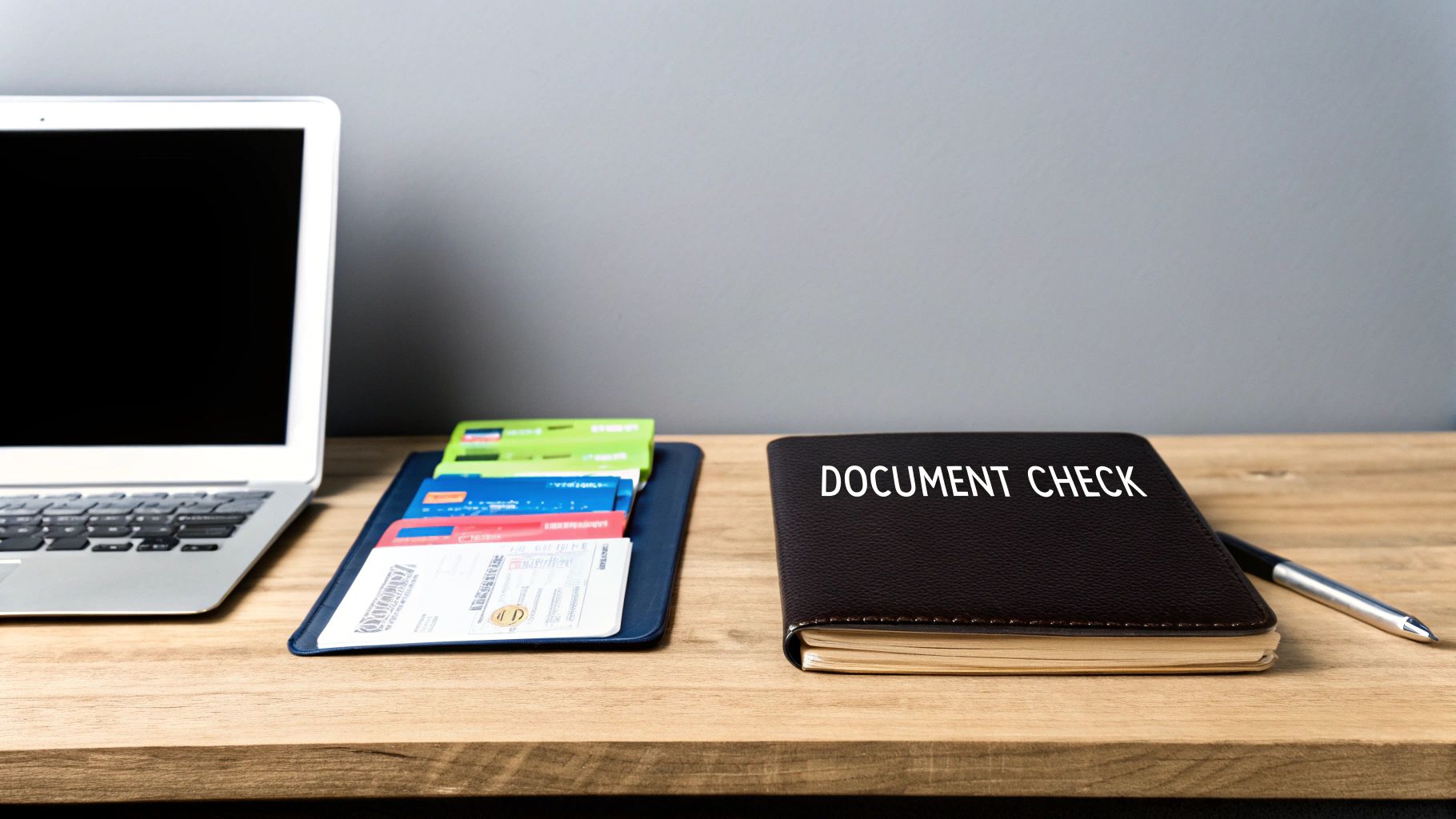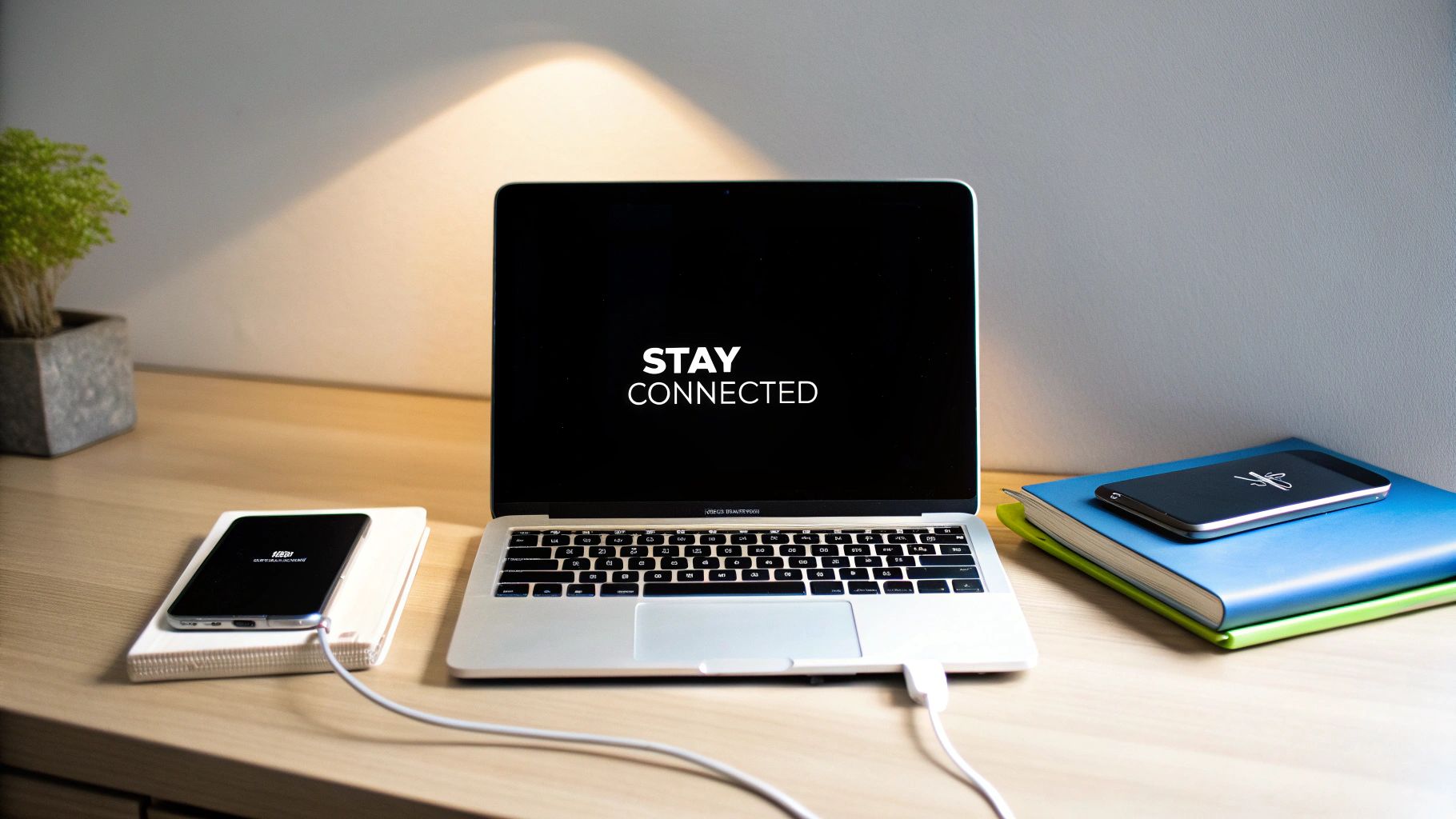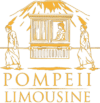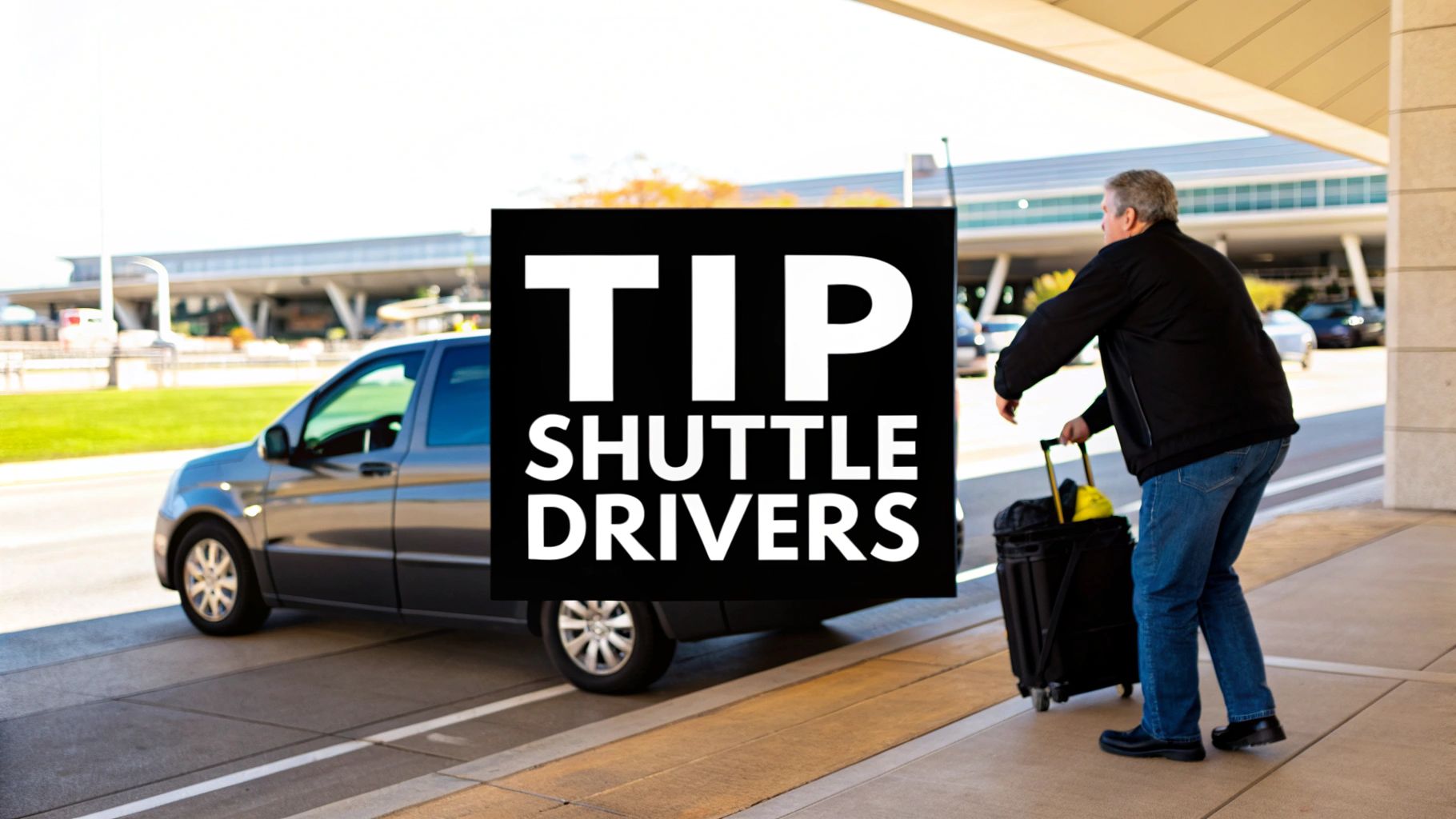Beyond Packing: Systematizing Your Business Travel for Peak Performance
In the world of high-stakes business, travel isn't a vacation; it's a strategic mission where success hinges on meticulous preparation. A simple list of what to pack is no longer sufficient for the modern professional. True readiness comes from building robust systems that manage every phase of the journey, from pre-departure planning to post-trip reporting. This comprehensive business travel checklist is engineered not just as a reminder, but as a framework for creating repeatable processes that minimize friction, reduce stress, and maximize your effectiveness on the road.
We will explore seven core systems that transform chaotic trips into seamless, productive extensions of your office. Think of each business trip as a self-contained project. To truly systematize your business travel for peak performance, it's essential to master project workflow management, ensuring every aspect of your trip is planned with efficiency. By mastering areas like document management, strategic booking, and itinerary optimization, you'll move beyond simply arriving prepared; you'll arrive with a clear competitive advantage. This guide is your blueprint for turning travel from a necessary chore into a powerful tool for success.
1. Travel Document Verification and Management
The foundation of any successful business trip is a flawless document management strategy. This isn't just about grabbing your passport on the way out the door; it’s about creating a comprehensive, multi-layered system that ensures legal compliance and smooth transit through every checkpoint. A proactive approach to organizing, verifying, and securing your documentation eliminates the single most common point of failure for international travelers, preventing costly delays and maintaining your professional credibility.


This essential step in your business travel checklist involves more than just a quick glance. Top consulting firms like McKinsey & Company and financial institutions such as Goldman Sachs often utilize centralized systems to track employee visa requirements and passport validity, a best practice any professional can adopt. The goal is to build a personal system that is both digital and physical, creating redundancy that protects you from theft, loss, or technological failure.
Building Your Foolproof Document System
Your system should consist of two main components: a digital wallet and a physical file.
- The Digital Wallet: Use a secure, cloud-based application like TripIt or even a password-protected folder on a service like Google Drive or Dropbox. Before every trip, scan or photograph high-quality images of your passport photo page, relevant visas, driver’s license, national ID card, and key business cards. This provides immediate access if your physical documents are lost.
- The Physical File: Keep a dedicated travel folio with physical photocopies of these same documents. Crucially, never store this backup file in the same bag as your original passport and wallet. Pack it in your checked luggage or a separate carry-on to mitigate risk.
Actionable Verification Protocol
Verification is an ongoing process, not a one-time check. Ensuring your travel documents, especially your passport, are current and valid is the first step in hassle-free international business travel. You can even consider options for renewing your passport online to streamline the process. Immediately after a trip is booked, research the specific entry requirements for your destination, as some countries require at least six months of passport validity beyond your planned departure date. Set a calendar reminder for nine months before your passport's expiration to give yourself ample time for renewal without paying for expedited services. This proactive management ensures you are always prepared.
2. Flight and Accommodation Strategic Booking
Beyond simply finding a flight and a bed, strategic booking is a systematic process designed to optimize your travel arrangements for cost, convenience, and productivity. This approach treats booking not as a mere transaction but as a critical component of your overall business objective. It involves a calculated balance of timing, loyalty program leverage, and location analysis to ensure your travel logistics actively support your professional goals, rather than detract from them. A well-executed booking strategy minimizes travel friction, preserves your energy for critical meetings, and can significantly impact your company's bottom line.


This methodical approach is a cornerstone of effective corporate travel management. Industry leaders like Deloitte, which reportedly saves over 15% annually through its preferred hotel partnerships, demonstrate the power of strategic relationships. Similarly, tech giants like Salesforce mandate the use of platforms like Concur to enforce booking compliance and leverage pre-negotiated rates. The core principle is to move from reactive, last-minute booking to a proactive system that aligns every choice with efficiency and comfort, a vital part of any comprehensive business travel checklist.
Developing Your Strategic Booking Framework
A robust framework integrates company policy with personal preference to create a seamless experience.
- Centralize with Platforms: If your company uses a travel management platform like Concur or Expensify, make it your primary tool. These systems are designed to automate compliance, aggregate corporate rates, and streamline expense reporting.
- Leverage Loyalty: Consolidate your travel with one or two airline alliances and hotel chains (like Marriott Bonvoy or Hilton Honors). This concentration accelerates your path to elite status, unlocking perks like upgrades, lounge access, and flexible check-in/out times that enhance comfort and productivity.
Actionable Booking Protocol
Timing and location are the two most critical variables in your booking protocol.
- Timing is Everything: For domestic flights, aim to book 3 to 6 weeks in advance to hit the sweet spot for pricing. International travel often requires a longer lead time of 2 to 4 months.
- Proximity Pays Dividends: When selecting a hotel, prioritize proximity to your primary meeting locations. A hotel within a 15-minute commute dramatically reduces transit time and stress. For trips with tight schedules, a hotel near the airport can be more strategic than one in the city center.
- Flexibility is Key: Always opt for refundable or flexible booking rates, especially when your schedule is tentative. The small premium is valuable insurance against costly cancellation fees if plans change.
3. Technology and Communication Setup
In today's hyper-connected business world, your technology is your lifeline. A robust technology and communication setup is no longer optional; it’s a critical component of a successful business travel checklist that ensures you remain productive, secure, and accessible, regardless of your location. This involves a proactive strategy for your hardware, software, and connectivity, preventing disruptions that can compromise client communications, miss deadlines, or expose sensitive company data.


This preparation goes far beyond simply packing your laptop and phone. Leading technology and consulting firms have established stringent protocols that every professional can model. For instance, companies like Microsoft and PwC mandate the use of specific VPNs and encrypted messaging apps to protect client and company information. The objective is to create a personal tech ecosystem that is resilient, secure, and prepared for any connectivity challenges you might face abroad, ensuring you can operate as efficiently on the road as you do in the office.
Building Your Mobile Command Center
Your setup should focus on power, connectivity, and security, turning your travel gear into a reliable mobile office.
- Hardware Arsenal: Your essential kit should include a fully charged portable battery pack (power bank), a universal travel adapter with multiple USB ports, and all necessary charging cables. Consider noise-canceling headphones for focus during travel and in busy environments. These tools ensure your devices remain powered and functional through long-haul flights and back-to-back meetings.
- Software and Security Fortification: Before departure, ensure your devices have the latest operating system and security updates installed. Test your company's VPN to guarantee you can access necessary files and systems securely. Download offline maps for your destination city and a translation app to navigate language barriers without relying on a data connection.
Actionable Connectivity Protocol
A reliable connection is paramount. Confirm your international communication plan well before you leave.
- Pre-Trip Connectivity Check: Contact your mobile provider to understand your international roaming options, data packages, or consider purchasing a local or international SIM card upon arrival for more cost-effective data.
- Backup Communication Plan: Use Wi-Fi-based messaging apps like WhatsApp or Telegram for cost-effective international communication. Set up automatic email forwarding or an out-of-office message that directs urgent inquiries to a colleague, ensuring critical tasks are handled in your absence. This layered communication strategy guarantees you are always reachable without incurring exorbitant fees.
4. Financial Planning and Expense Management
A structured approach to travel finances is a critical component of any business travel checklist, transforming expense management from a reactive chore into a proactive strategy. This involves more than just having a company card; it's about creating a comprehensive system for budgeting, payment, currency exchange, and tracking that ensures compliance with corporate policy, streamlines reimbursement, and provides a clear financial overview of your trip. A well-executed financial plan minimizes personal liability and maintains a professional, organized approach to company resources.


This systematic approach is standard practice in top-tier organizations. For instance, global firms like Ernst & Young and KPMG often utilize platforms like Concur for automated expense reporting and implement strict per diem policies to simplify management. Similarly, financial giants such as JPMorgan Chase provide corporate travel cards with built-in spending controls. The goal is to build a personal financial system that aligns with these corporate best practices, ensuring every dollar is accounted for efficiently and accurately.
Creating Your Travel Financial System
Your system should integrate pre-trip planning with in-trip execution to prevent financial surprises and simplify post-trip reporting.
- Payment & Currency Strategy: Before departure, notify your credit and debit card issuers of your travel dates and destinations to avoid fraud alerts that could freeze your accounts. Research currency exchange options, often finding that using an ATM at your destination provides better rates than airport kiosks. Always carry at least two different payment methods, like a primary corporate card and a personal backup card, plus a small amount of local currency for incidentals.
- Expense Tracking & Reporting: Utilize a modern expense tracking app, many of which offer receipt scanning and categorization features. Take a clear photo of every receipt immediately after a transaction. This creates an instant digital backup and reduces the risk of losing small paper receipts, which can delay or prevent reimbursement.
Actionable Financial Protocol
Proactive financial management begins the moment a trip is confirmed. Start by thoroughly reviewing your company's travel and expense policy, paying close attention to per diem rates, spending limits on categories like meals and entertainment, and non-reimbursable items. Set up a dedicated folder in your expense tracking app for the specific trip. This level of organization is essential for maintaining accurate records and ensuring a smooth reimbursement process, allowing you to focus on your business objectives rather than financial administration.
5. Health and Safety Preparation
A robust health and safety protocol is a non-negotiable component of any professional business travel checklist. This extends beyond packing a simple first-aid kit; it involves a systematic approach to medical preparation, insurance coverage, and emergency planning tailored to your specific destination. Proactively managing your health protects you from preventable illnesses and ensures you have a clear action plan for any medical situation, allowing you to focus on your business objectives with peace of mind.
This essential step is a cornerstone of corporate risk management. Global organizations like Shell and the World Bank have stringent pre-travel health protocols, including mandatory medical briefings and clearances for high-risk regions. Following their lead, every business traveler should build a personal health strategy. This includes understanding potential health risks, securing adequate medical resources, and preparing for the physical toll of travel. Given the disruptions of travel, prioritizing strategies for deep and restorative sleep is crucial for maintaining both physical health and mental sharpness.
Building Your Pre-Travel Health Protocol
Your protocol should cover three core areas: medical readiness, insurance, and emergency contacts.
- Medical Readiness Kit: Assemble a personalized medical kit. Beyond basics like bandages and pain relievers, include any prescription medications in their original, labeled containers along with a copy of the prescription. Also pack over-the-counter remedies for common travel ailments like digestive issues or allergies.
- Comprehensive Travel Insurance: Review your company’s policy or purchase a personal plan. Ensure it covers medical emergencies, evacuation, and trip cancellation. Verify the coverage limits and understand the claims process before you depart. Companies like Allianz and World Nomads offer policies designed specifically for international travel.
Actionable Health & Safety Checklist
Implement this checklist 4-6 weeks before your departure to ensure you are fully prepared.
- Consult a Professional: Schedule an appointment with a travel medicine clinic or your primary care physician. Discuss your destination to determine required vaccinations (e.g., Yellow Fever, Typhoid) and preventative medications (e.g., for malaria).
- Document and Digitize: Keep a letter from your doctor detailing any prescription medications you carry. Store digital copies of this letter, your prescriptions, and your insurance card in a secure cloud folder.
- Research Local Infrastructure: Before you go, identify reputable hospitals or clinics near your hotel and meeting locations. Save their addresses and phone numbers offline in your phone.
- Register Your Trip: For international travel, register with your country's embassy or consulate through programs like the U.S. State Department's Smart Traveler Enrollment Program (STEP). This service provides security updates and helps officials locate you in an emergency.
6. Business Materials and Presentation Preparation
Your professional success on a business trip hinges on flawless execution, which is directly tied to the readiness of your materials. Preparing your business assets is not merely about printing handouts; it is a strategic process of organizing, backing up, and securing everything from presentations to product samples. This systematic approach ensures you arrive ready to engage, confident in your ability to handle any technical glitch or unexpected meeting, thereby safeguarding your professional reputation and the trip's objectives.
This critical component of your business travel checklist is a standard operating procedure for top-tier organizations. Tech giants like Apple ensure executives carry multiple backup devices for keynote demonstrations, while management consulting firms such as BCG mandate cloud-based presentation systems with robust offline capabilities. The core principle is redundancy and accessibility, creating a bulletproof system that guarantees your key materials are always available, secure, and functional, regardless of the circumstances.
Establishing Your Professional Readiness System
Your preparation should be built around a multi-layered system that covers digital, physical, and technical readiness.
- The Digital Arsenal: Save your final presentation in multiple formats (e.g., .pptx, .pdf) to prevent compatibility issues. Store these files across different platforms: a primary cloud service like Google Drive or OneDrive for easy access, a secondary USB flash drive, and a local copy on your laptop. This triple redundancy protects against internet failure, device loss, or file corruption.
- The Physical Toolkit: Always pack essential business materials in your carry-on luggage. This includes printed copies of your presentation, marketing collateral, product samples, and an ample supply of business cards. Consider having cards printed with a local language translation on one side, a small detail that demonstrates respect and foresight.
Pre-Departure Material Protocol
Finalizing your materials is a proactive task that should be completed days before you travel, not hours. Test every piece of technical equipment you plan to use, including projectors, adapters, and clickers, to ensure they are functioning correctly and are compatible with your devices. Prepare a concise "elevator pitch" about your project or company, and if applicable, learn key phrases in the local language to build rapport. This meticulous preparation prevents last-minute scrambles and allows you to focus entirely on your business objectives upon arrival.
7. Itinerary and Schedule Optimization
A masterfully planned itinerary is the engine of a productive business trip. This goes far beyond simply listing appointments; it involves a strategic approach to scheduling that maximizes efficiency, respects cultural nuances, and actively minimizes travel fatigue. By optimizing your schedule, you transform a potentially chaotic trip into a focused, high-impact engagement, ensuring you arrive at every meeting sharp, prepared, and in control. This level of planning is a hallmark of a seasoned professional and a critical component of any business travel checklist.
This strategic scheduling is not just a nice-to-have; it's a standard operating procedure for high-performance organizations. Top investment banks like Goldman Sachs meticulously optimize multi-city client visit schedules to maximize face time and minimize transit hours. Similarly, diplomatic services employ cultural attachés to brief officials on local business etiquette, ensuring meetings begin on the right foot. The goal is to create a schedule that is ambitious yet realistic, balancing business objectives with the very real demands of travel.
Architecting a High-Performance Itinerary
A truly optimized schedule considers energy levels, logistics, and local customs.
- Time Zone Acclimation: For international travel, plan to arrive at least 24 hours before your first critical meeting. This buffer allows your body to begin adjusting to the new time zone, combating jet lag and ensuring you are mentally alert for important discussions.
- Energy-Based Scheduling: Identify your personal peak productivity hours. Schedule your most important, high-stakes meetings during these windows. Relegate less critical tasks, like administrative follow-ups or casual networking coffees, to your lower-energy periods, such as the late afternoon.
Actionable Scheduling Protocol
Fine-tune your schedule with tactical precision to ensure seamless execution.
- Implement Buffer Time: One of the most effective strategies, used by executives at companies like Amazon, is to build in buffer periods. Schedule a minimum of 30-minute gaps between appointments to account for traffic, meeting overruns, or a moment to decompress and review notes.
- Leverage Technology: Use scheduling tools like Calendly or a simple shared Google Calendar that can display multiple time zones simultaneously. This prevents confusion and miscommunication when coordinating with colleagues and clients across the globe.
- Cultural Research: Before your trip, research local business customs. Understanding norms around punctuality, greeting protocols, and gift-giving can prevent embarrassing missteps and build rapport, setting the stage for a more successful business outcome.
Business Travel Checklist: 7 Key Elements Compared
| Item | Implementation Complexity 🔄 | Resource Requirements ⚡ | Expected Outcomes 📊 | Ideal Use Cases 💡 | Key Advantages ⭐ |
|---|---|---|---|---|---|
| Travel Document Verification and Management | Moderate – requires ongoing updates and initial setup | Moderate – time and digital storage needed | Legal compliance and smooth border crossings | Frequent international travelers and corporate travel | Prevents delays, ensures compliance, quick access |
| Flight and Accommodation Strategic Booking | Moderate – managing loyalty programs and bookings | Moderate – time to negotiate and monitor | Cost savings, schedule flexibility, comfortable stays | Business travel with frequent bookings | Cost efficiency, priority upgrades, stress reduction |
| Technology and Communication Setup | High – technical setup, VPNs, device management | High – technical knowledge and extra equipment | Secure communication and uninterrupted connectivity | International travel involving critical communication | Maintains productivity, data security, redundancy |
| Financial Planning and Expense Management | Moderate – expense tracking and budgeting processes | Moderate – apps and corporate cards | Budget control, streamlined reimbursement | Business travelers managing expenses | Real-time expense visibility, better exchange rates |
| Health and Safety Preparation | Moderate to High – medical and insurance compliance | Moderate – consultations, insurance costs | Reduced health risk, compliance with health policies | Travelers to high-risk or regulated destinations | Protects health, offers peace of mind, risk compliance |
| Business Materials and Presentation Preparation | Moderate – organizing and securing materials | Moderate – physical materials and backups | Professional readiness and successful meetings | Presentations, demos, client meetings | Enhances professionalism, prevents failures, customization |
| Itinerary and Schedule Optimization | High – complex coordination and contingency planning | Moderate – scheduling tools and research | Increased productivity, reduced fatigue | Intense business trip schedules across time zones | Maximizes productivity, reduces fatigue, cultural prep |
Integrating Your Systems for Effortless Execution
A comprehensive business travel checklist is more than a simple list of items to pack; it's a strategic framework for success. The seven core systems we've explored, from meticulous document management to dynamic itinerary optimization, are designed to function as an integrated whole. Each pillar, whether it's strategic booking, technology setup, or financial planning, supports the others to transform chaotic travel into a streamlined, high-performance experience. Think of it not as a series of isolated tasks but as a single, cohesive operational plan for your journey.
The true power of this approach lies in its iterative nature. Your first trip using this detailed framework will establish a baseline. Subsequent journeys provide opportunities for refinement. Did your tech setup falter? Was your schedule too rigid? Each trip becomes a data point, allowing you to fine-tune your personal protocol, making your business travel checklist a living document that evolves with your needs and experiences. This commitment to preparation isn't just about avoiding forgotten chargers or missed flights; it’s about engineering a successful business outcome before you even leave home.
Key Takeaways for the Modern Business Traveler
Mastering your travel routine is a significant competitive advantage. It conserves your most valuable resources: time, energy, and mental focus. By systematizing your preparation, you eliminate the friction and decision fatigue that plague so many professionals on the road.
Here are the most critical takeaways to implement immediately:
- System Over List: Shift your mindset from a simple checklist to a series of interconnected systems. How does your financial planning system talk to your itinerary system? How does your tech prep support your presentation goals? This integrated view is the key to seamless execution.
- Proactive vs. Reactive: This entire framework is built on proactivity. Verifying documents weeks in advance, booking strategically for comfort and convenience, and preparing for health contingencies are all proactive measures that prevent reactive scrambling later.
- The Post-Trip Audit is Non-Negotiable: The journey isn't over when you land back home. The post-trip phase, involving expense reconciliation and a personal performance review, is where you gain the insights needed to make your next trip even more efficient. Skipping this step means leaving valuable lessons on the table.
Ultimately, the goal is to make this robust level of preparation an automatic habit. When the logistics of travel fade into the background, your cognitive resources are freed up to concentrate entirely on your primary objectives, whether that's delivering a compelling presentation, negotiating a critical contract, or fostering key client relationships. This is how you move from simply surviving business travel to truly thriving in it.
For professionals traveling to or from the San Diego area, ensuring your ground transportation is just as meticulously planned as the rest of your trip is paramount. Finalize your business travel checklist by securing reliable, professional transport with Pompeii Limousine. Their commitment to punctuality and premium service ensures your journey begins and ends with the same efficiency and focus you've applied to your entire travel plan.




